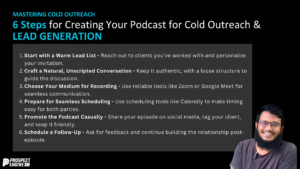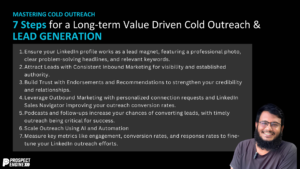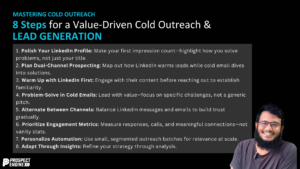Welcome to the ultimate guide on how to maximize B2B lead generation activities for business growth! In today’s competitive business landscape, generating potential high-quality leads is crucial for ensuring long-term success. In this comprehensive guide, we will walk you through the key strategies and best practices to supercharge your B2B lead generation efforts.
Before delving into the specifics, let’s understand the importance of B2B lead generation activities for business growth. Effective lead generation not only drives a steady stream of potential customers but also allows businesses to establish meaningful relationships, improve sales conversion rates, and ultimately expand their market share.
Now, let’s dive into the actionable steps that will help you make the most out of your efforts!
Define Your Ideal Customer Profile
Every successful B2B lead generation strategy starts with a clear understanding of your ideal customer profile. Defining your ICP enables you to focus your resources on the most promising leads and tailor your marketing messages to resonate with their needs and pain points.
Start with identifying the target industries or sectors that align with your products or services. Consider factors such as company size, annual revenue, and geographical location to fine-tune your target audience. Additionally, research decision-makers who have the authority to make purchasing decisions within your target companies.
Utilizing data analytics and market research can significantly enhance your ICP. Analyze historical customer data, conduct surveys, and leverage industry reports to gain insights into your target audience’s preferences, challenges, and goals. This data-driven approach will empower you to refine your ICP and make informed decisions throughout your lead generation journey.
Building a Strong B2B lead generation activities strategy
Content Marketing
Content marketing serves as the backbone of any successful B2B lead generation activities strategy. By creating high-quality content that addresses your target audience’s pain points and offers valuable solutions, you can position yourself as a trusted industry expert and attract qualified leads.
Start by developing a content calendar and consistently producing informative blog posts, whitepapers, case studies, and eBooks. Optimize your content for search engines by incorporating relevant keywords, meta tags, and authoritative backlinks. This will enhance your online visibility and drive organic traffic, resulting in increased lead generation.
Remember, compelling content alone is not enough; you need to actively promote it. Leverage social media platforms, professional forums, and online communities to distribute and extend the reach of your content. Engage with your audience by responding to comments, addressing inquiries, and sharing relevant industry insights. This two-way communication will foster trust and encourage potential leads to take further action.
Social Media Marketing
Social media marketing offers unparalleled opportunities to connect with your target audience and generate leads. Start by selecting the right social media platforms where your audience is most active. For instance, LinkedIn is a popular choice for B2B lead generation due to its professional networking nature.
Develop a consistent posting schedule and share a variety of content, including industry news, educational resources, and thought leadership pieces. Engaging visuals, such as infographics and videos, can further enhance your social media presence. Encourage social sharing of your content to expand your reach and attract more leads.
To amplify your lead generation efforts, invest in targeted social media advertising. Platforms like Facebook and LinkedIn offer powerful ad targeting options, enabling you to specify your target audience based on demographics, job titles, and company size. Run paid campaigns with compelling ad copies and eye-catching visuals to capture the attention of potential leads and direct them to your landing pages or lead capture forms.
Email Marketing
Email marketing remains a vital tool for nurturing leads and driving conversions. Build a robust email list by strategically placing opt-in forms on your website, blog, or landing pages. Offer valuable incentives, such as exclusive resources or discounts, in exchange for visitors’ email addresses.
Segment your email list based on customer preferences, behaviors, and demographics. By sending targeted and personalized campaigns, you can enhance relevance and increase engagement. Craft compelling subject lines and email copies that address your audience’s pain points and highlight the value your products or services bring.
Automate your email sequences to nurture leads at different stages of the buyer’s journey. Implementing marketing automation tools like Mailchimp or HubSpot allows you to deliver relevant content and timely follow-ups. Consider incorporating lead scoring to prioritize and identify warm leads that are more likely to convert into customers.
Utilizing Lead Magnets to Capture Leads
Lead magnets are invaluable assets in your lead generation arsenal. These enticing offers attract potential leads and entice them to provide their contact information in exchange for valuable content or resources. Common lead magnets include eBooks, webinars, free trials, case studies, and industry reports.
To create effective lead magnets, first, identify the pain points and challenges your target audience faces. Develop content that provides actionable solutions or valuable insights. Package your lead magnet with an attractive and concise landing page that clearly communicates the benefits recipients will gain from downloading or accessing the resource.
Ensure your lead magnets align with the overall messaging and brand positioning of your business. By delivering value upfront, you establish credibility and lay the groundwork for a potential business relationship.
Lead Nurturing and Conversion
Implementing Marketing Automation
Marketing automation streamlines lead nurturing and free up your time for high-value tasks. It allows you to deliver personalized and timely content to leads based on their actions, behaviors, and interests.
Invest in marketing automation tools that integrate seamlessly with your existing systems. These tools enable you to define workflows and automate email sequences, ensuring that leads receive relevant content throughout their journey.
By implementing lead scoring, you can assign points based on lead demographics, engagement with your content, and interactions with your website. This helps you identify and prioritize highly qualified leads for sales follow-up.
Sales and Marketing Alignment
Achieving sales and marketing alignment is essential for maximizing lead conversion rates. Both departments must work in sync to ensure the handoff from marketing-qualified leads (MQLs) to sales-qualified leads (SQLs) is seamless.
Collaborate with your sales team to define lead qualification criteria. Clearly communicate the definition of an ideal lead, including parameters like budget, timeline, and decision-making authority.
Establish a closed-loop feedback system to continuously refine your lead generation strategies. Analyze conversion rates, sales deal velocity, and feedback from the sales team to identify areas of improvement. By regularly revisiting your lead generation approach, you can optimize your efforts and increase overall business growth.
Analyzing and Optimizing Your Lead Generation Efforts
Tracking and analyzing key metrics is crucial to gauge the success of your lead generation activities. Monitor conversion rates, click-through rates, and lead-to-opportunity ratio to assess the effectiveness of your strategies.
Identify areas that require improvement and optimize your lead generation efforts accordingly. A/B test different elements of your landing pages, email campaigns, and ad copies to identify what resonates best with your target audience.
Stay agile and adapt to the evolving landscape of B2B lead generation. Consumer behaviors and preferences change over time, so it’s important to continuously refine your strategies based on data-driven insights.
Conclusion
Congratulations! You now have the roadmap to supercharge your B2B lead generation activities for business growth. By following the steps outlined in this comprehensive guide, you can attract high-quality leads, nurture them effectively, and convert them into loyal customers.
Remember, successful lead generation is an ongoing process that requires continuous effort, analysis, and adaptation. Keep experimenting, testing new approaches, and leveraging data to optimize your lead generation strategies. By doing so, you will be well-positioned to achieve sustainable growth and stay ahead in today’s competitive B2B landscape. Good luck!





